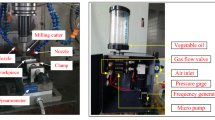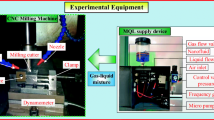Abstract
The objective of this research is to experimentally evaluate the lubrication performances of different nanofluids in milling titanium alloy Ti-6Al-4V. Six types of nanofluids, namely, Al2O3, SiO2, MoS2, CNTs, SiC, and graphite, were selected. Cottonseed oil was used as the base oil. The lubrication performance was investigated in terms of milling force, surface roughness, and morphology of workpiece surface. Experimental results demonstrated that the Al2O3 nanoparticle obtained the minimal milling force (Fx = 277.5 N, Fy = 88.3 N), followed by the SiO2 nanoparticle (Fx = 283.6 N, Fy = 86.5 N). The surface roughness obtained by the Al2O3 nanofluid was the minimum (Ra = 0.594 μm), whereas it was the maximum by using minimum quantity lubrication (Ra = 1.772 μm). The surface roughness of the six nanofluids was described by the following order: Al2O3 < SiO2 < MoS2 < CNTs < graphite < SiC. The workpiece surface morphology was the best for Al2O3 and SiO2. The viscosity of the nanofluids was also analyzed. Spherical Al2O3 and SiO2 nanoparticles improved the lubrication effect of base oil mostly and were more suitable as environment-friendly additives for the base oil compared with the others.
Similar content being viewed by others
References
Ulutan D, Ozl T (2011) Machining induced surface integrity in titanium and nickel alloys. Int J Machine Tools Manuf 55:250–280
Su Y, He N, Li L (2010) Experimental study on high speed milling titanium alloys using cryogenic minimum quantity. China Mech Eng 21:2665–2670
Ekinovic S, Prcanovic H, Begovic E (2015) Investigation of influence of MQL machining parameters on cutting forces during MQL turning of carbon steel St52-3. Rrocescia Eng 132:608–614
Khan MMA, Mithu MAH, Dhar NR (2009) Effects of minimum quantity lubrication onturning AISI 9310 alloysteel using vegetable oil-based cutting fluid. J Mater Process Technol 209:5573–5583
Li CH, Li JY, Wang S, Jia DZ (2013) Modeling and numerical simulation of the grinding temperature distribution with nano-particle jet of MQL. Adv Mech Eng 7:167–181
Pervaiz S, Rashid A, Deiab I, Nicolescu CM (2016) An experimental investigation on effect of minimum quantity cooling lubrication(MQCL) in machining titanium alloy (Ti6Al4V). Int J Adv Manuf Technol 87:1371–1386
Rahim E, Sasahara H (2011) A study of the effect of palm oil as MQL lubricant on high speed drilling of titanium alloys. Tribol Int 44:309–317
Mark BD, Sabarish VN, Hariharan MV, Samuel RD (2018) On the benefits of sub-zero air upplemented minimum quantity lubrication systems: an experimental and mechanistic investigation on end milling of Ti-6Al-4V alloy. Tribol Int 119:464–473
Ding WF, Zhang LC, Li Z, Zhu YJ, Su HH, Xu JH (2017) Review on grinding-induced residual stresses in metallic materials. Int J Adv Manuf Technol 88:2939–2968
Ding WF, Barbara L, Zhu YJ, Li Z, Fu YC, Su HH, Xu JH (2017) Review on monolayer CBN superabrasive wheels for grinding metallic materials. Chin J Aeronaut 30:109–134
Wang YG, Li CH, Zhang YB, Yang M, Li BK, Jia DZ, Hou YL, Mao C (2016) Experimental evaluation of the lubrication properties of the wheel/workpiece interface in minimum quantity lubrication (MQL) grinding using different types of vegetable oils. J Clean Prod 127:487–499
Li BK, Li CH, Zhang YB, Wang YG, Yang M, Jia DZ, Zhang NQ, Wu QD (2017) Effect of the physical properties of different vegetable oil-based nanofluids on MQLC grinding temperature of Ni-based alloy. Int J Adv Manuf Technol 89:3459–3474
Zhang YB, Li CH, Ji HJ, Yang XH, Yang M, Jia DZ, Zhang XP, Li RZ, Wang J (2017) Analysis of grinding mechanics and improved predictive force model based on material-removal and plastic-stacking mechanisms. Int J Mach Tools Manuf 122:81–97
Park KH, Ewald B, Kwon PY (2011) Effect of nano-enhanced lubricant in minimum quantity lubrication balling milling. J Tribol 133:3526–3537
Zhang DK, Li CH, Jia DZ, Zhang YB, Zhang XP (2015) Specific grinding energy and surface roughness of nanoparticle jet minimum quantity lubrication in grinding. Chin J Aeronaut 28:570–581
Zhang XP, Li CH, Zhang YB, Jia DZ, Li BK, Wang YG, Yang M, Hou YL, Zhang XW (2016) Performances of Al2O3/SiC hybrid nanofluids in minimum-quantity lubrication grinding. Int J Adv Manuf Technol 86(1–15):3427–3441
Wang YG, Li CH, Zhang YB, Yang M, Zhang XP, Zhang NQ, Dai JJ (2016) Experimental evaluation on tribological performance of the wheel/workpiece interface in minimum quantity lubrication grinding with different concentrations of Al2O3 nanofluids. J Clean Prod 142:3571–3583
Mao C, Tang XJ, Zou HF, Huang XM, Zhou ZX (2012) Investigation of grinding characteristic using nanofluid minimum quantity lubrication. Int J Precis Eng Man 13:1745–1752
Mao C, Zou HF, Huang XM, Zhang JA Zhou ZX (2013) The influence of spraying parameters on grinding performance for nanofluid minimum quantity lubrication. Int J Adv Manuf Technol 64:1791–1799
Shen B, Shih AJ, Tung SC (2008) Application of nanofluids in minimum quantity lubrication grinding. Tribol T 51:730–737
Shen B, Kalita P, Malshe AP, Shih A (2008) Performance of novel MoS2 nanoparticles based grinding fluids in minimum quantity lubrication grinding. Trans NAMRI/SME 36:357–364
Kalita P, Malshe AP, Kumar SA, Yoganath VG, Gurumurthy T (2012) Study of specific energy and friction coefficient in minimum quantity lubrication grinding using oil-based nanolubricants. J Manuf Process 14:160–166
Krishna PV, Srikant RR, Rao DN (2010) Experimental investigation on the performance of nanoboric acid suspensions in SAE-40 and coconut oil during turning of AISI 1040 steel. Int J Mach Tools Manuf 50:911–916
Rao SN, Satyanarayana B (2011) Experimental estimation of tool wear and cutting temperatures in MQL using cutting fluids with CNT inclusion. Int J Eng Sci Technol 3:928–931
Yan J, Zhang Z, Kuriyagawa T (2011) Effect of nanoparticle lubrication in diamond turning of reaction-bonded SiC. Int J Autom Technol 5:307–312
Khandekar S, Sankar MR, Agnihotri V, Ramkumar J (2012) Nano-cutting fluid for enhancement of metal cutting performance. Mater Manuf Process 27:963–967
Prasad MMS, Srikant RR (2013) Performance evaluation of nano graphite inclusion in cutting fluids with MQL technique in turning of AISI 1040 steel. Int J Res Eng Technol 2:381–393
Su Y, Gong L, Li B, Liu Z, Chen D (2016) Performance evaluation of nanofluid MQL with vegetable-based oil and ester oil as base fluids in turning. Int J Adv Manuf Technol 83:2083–2089
Sayuti M, Sarhan AAD, Hamdi M (2013) An investigation of optimum SiO2 nanolubrication parameters in end milling of aerospace Al6061-T6 alloy. Int J Adv Manuf Technol 67:833–849
Sayuti EO, Sarhan AAD (2013) Investigation on the morphology of the machined surface in end milling of aerospace AL6061-T6 for novel uses of SiO2 nanolubrication system. J Cleaner Prod 66:655–663
Ming EO, Sayuti M, Sarhan AAD (2015) Fuzzy logic-based approach to investigate the novel uses of nano suspended lubrication in precise machining of aerospace AL tempered grade 6061. J Clean Prod 89:286–295
Marcon A, Melkote S, Kalaitzidou K, DeBra D (2010) An experimental evaluation of graphite nanoplatelet base-d lubricant in micro-milling. CIRP Ann Manuf Technol 59:141–144
Rahmati B, Sarhan AAD, Sayut M (2013) Morphology of surface generated by end milling AL6061-T6 using molybdenum disulfide (MoS2) nanolubrication in end milling machining. J Clean Prod 66:685–691
Rahmati B, Sarhan AAD, Sayuti M (2014) Investigating the optimum molybdenum disulfide (MoS2) nanolu-brication parameters in CNC milling of AL6061-T6 alloy. Int J Adv Manuf Technol 70:1143–1155
Uysal A, Demiren F, Altan E (2015) Applying minimum quantity lubrication (MQL) method on milling of martensitic stainless steel by using nano MoS2 reinforced vegetable cutting fluid. Procedia Soc Behav Sci 195:2742–2747
Najiha MS, Rahman MM, Kadirgama K (2016) Performance of water-based TiO2 nanofluid during the minim-um quantity lubrication machining of aluminium alloy AA6061-T6. J Clean Prod 135:1623–1636
Hadi M, Atefi R (2015) Effect of minimum quantity lubrication with gamma-Al2O3 nanoparticles on surface roughness in milling AISI D3 steel. Ind J Sci Technol 8:296–300
Yin QA, Li CH, Zhang YB, Yang M, Jia DZ, Hou YL, Li RZ, Dong L (2018) Spectral analysis and power spectral density evaluation in Al2O3 nanofluid minimum quantity lubrication milling of 45 steel. Int J Adv Manuf Technol 97:129–145
Kim JS, Kim JW, Lee SW (2017) Experimental characterization onm icro-end milling of titanium alloy using nanofluid minimum quantity lubrication with chilly gas. Int J Adv Manuf Technol 91:2741–2749
Li M, Yu TB, Zhang RC (2018) MQL milling of TC4 alloy by dispersing graphene into vegetable oil-based cutting fluid. Int J Adv Manuf Technol 99:1735–1753
Lee PH, Nam JS, Li C, Lee SW (2012) An experimental study on micro-grinding process with nanofluid minimum quantity lubrication (MQL). Int J Precis Eng Manuf 13:331–338
Shi XL, Xiu SC, Zhang XM, Wang YS (2017) A study of PSHG and its characteristic mechanism of residual stress within a hardened layer. Int J Adv Manuf Technol 88(1):863–877
Deng YS, Xiu SC, Shi XL, Sun C, Wang YS (2017) Study on the effect mechanisms of pre-stress on residual stress and surface roughness in PSHG. Int J Adv Manuf Technol 88(9-12):3243–3256
Sia SY, Bassyony EZ, Sarhan AA (2014) Development of SiO2 nanolubrication system to be used in sliding bearings. Int J Adv Manuf Technol 71:1277–1284
Guo SM, Li CH, Zhang YB, Wang YG, Li BK, Yang M, Zhang XP, Liu GT (2016) Experimental evaluation of the lubrication performance of mixtures of castor oil with other vegetable oils in MQL grinding of nickel-based alloy. J Clean Prod 140:1060–1076
Yang M, Li CH, Zhang YB, Jia DZ, Zhang XP, Hou YL, Li RZ, Wang J (2017) Maximum undeformed equivalent chip thickness for ductile-brittle transition of zirconia ceramics under different lubrication conditions. Int J Mach Tools Manuf 122:55–65
Ge XY, Xia YQ, Cao ZF (2015) Tribological properties and insulation effect of nanometer TiO2 and nanometer SiO2 as additives in grease. Tribol Int 92:454–461
Funding
This research was financially supported by the following organizations: the National Natural Science Foundation of China (51806112 and 51575290); Shandong Provincial Natural Science Foundation, China (ZR2017PEE002 and ZR2017PEE011); and the Scientific Research Development Project of Shandong Higher Education Institutions, China (J18KA017 and J17KB016).
Author information
Authors and Affiliations
Corresponding author
Additional information
Highlights
• Lubrication performance of different nanofluids in milling Ti-6Al-4V was studied.
• The surface integrity of six typical nanoparticles were studied.
• EDS elements of different nanoparticles were analyzed to validate lubrication performance.
• The best lubrication performance was obtained by Al2O3 and SiO2 nanofluid MQL.
Rights and permissions
About this article
Cite this article
Bai, X., Li, C., Dong, L. et al. Experimental evaluation of the lubrication performances of different nanofluids for minimum quantity lubrication (MQL) in milling Ti-6Al-4V. Int J Adv Manuf Technol 101, 2621–2632 (2019). https://doi.org/10.1007/s00170-018-3100-9
Received:
Accepted:
Published:
Issue Date:
DOI: https://doi.org/10.1007/s00170-018-3100-9




